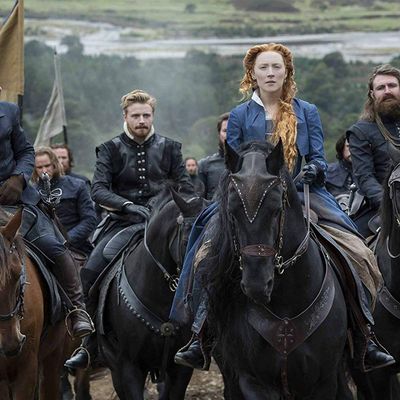
There was a small amount of outcry among history buffs this summer when the posters for Mary Queen of Scots were revealed. The two-character one-sheets featured striking, color-pumped head-on portraits of two 2017 awards-season darlings: Margot Robbie’s Queen Elizabeth emblazoned with the tagline “Born to Power,” Saoirse Ronan’s Mary Stuart with “Born to Fight.” Never mind, critics pointed out, that Mary became queen of Scotland when she was all of six days old, and that Elizabeth was denied her claim to the throne repeatedly until her half-sister Queen Mary died of cancer. The taglines would be more accurate swapped, but then, they wouldn’t make as intriguing a case for a movie called Mary Queen of Scots, and we already have two Elizabeth movies.
And it’s not like we see these costume dramas entirely for their historical value. These creative licenses are supposed to aid in our feeling more connected to figures from the past, get us a little closer to imagining all-night gabfests with Mary and her ladies-in-waiting, or being a member of Elizabeth’s court. (Seldom are we asked to imagine being in the historical shoes of anyone not royal, noble, or noble-adjacent, but that’s another conversation.) Sixteenth-century royals, they’re just like us! So when we are told that Mary was “born to fight,” and presented with Ronan’s plucky, fresh-faced underdog-from-the-sticks who pushes for religious freedom (i.e., you can be Protestant OR Catholic), cheers on her gender-nonconforming friend, and ruffles the puritanical feathers of fusty old John Knox (David Tennant), it is meant to evoke a rousing “Aye, Queen” in 21st-century viewers.
But despite, or perhaps because of these efforts, Mary Queen of Scots feels painfully old-fashioned, yet another type of movie that I suspect we no longer have much use for — the awards-season, low-concept costume drama. I must specify “low concept” because this year’s The Favourite proves its still possible to breathe life and invention and character into the well-worn genre, and with measurably more historical fidelity to boot. Like Yorgos Lanthimos’s film, Mary attempts to tell a story of a war between women in a time when we don’t necessarily think of such a thing being commonplace, with Mary, newly widowed at 18, back in Scotland to try for a claim at Elizabeth I’s very contentious seat on the throne. Several ideological differences separate them — most importantly, Mary’s Catholicism is an issue for newly reformed England — but in this telling, it is primarily the machinations of the men around them that keep Mary and Elizabeth from being the besties they were destined to be.
The screenplay, by House of Cards’ Beau Willimon, is heavy on the explanation of the political forces at work in 1560s England and Scotland, but it has a harder time molding its titular character into the Hollywood heroine it inexplicably feels determine to make her. Mary has been among the more controversial royal figures in history up to and since the moment of her death, and her ambition, unfortunate decision-making, and the juicy supposed plot to have her husband murdered are all what make her an enduring subject of fascination. It does not, however, make her into the woke underdog princess the movie tries to portray her as, nor Elizabeth into a desperate old clown as her foil.
Mary’s choice of husband is her greatest weapon in her royal ambition, but she eventually weds Lord Darnley (Jack Lowden) less for diplomatic advantage and more, as the film would have you believe, for his oral capabilities. (It doesn’t mention that Darnley was her first cousin, of course.) Her marriage and eventual child are contrasted with Elizabeth’s famous virginity, and Josie Rourke makes sure we can see the spinsterism curdling inside of Robbie, eating away at her smallpox-scarred face and making her eyes increasingly bloodshot. After the birth of Mary’s son, James, we’re presented with the side-by-side imagery of a blissful Mary surrounded by bloody afterbirth, and Elizabeth surrounded with red paper curlicues. No matter that we’ve seen James conceived more or less via rape by an angry, drunken, Darnley — Mary had a baby, objectively the greatest joy a woman can know.
It’s these bizarre, ahistorical reads married with the intermittent stabs at a boardroom’s idea of millennial values that render Mary a kind of nothing of a film. It’s neither a rigorous history lesson nor a particularly interesting work of drama and character, and it ends up doing the exact same things — pitting women against each other, fixating on fertility and virginity — it claims to find so oppressive for its heroine. It has a feeling about its subject, but no real ideas. Of course, it’s not the first lusciously appointed period drama to fall into this middlebrow zone, but it makes a pretty good case that it should be one of the last.
Mary Queen of Scots was nominated for two Oscars in 2019, including Best Makeup and Hairstyling and Best Costume Design.

